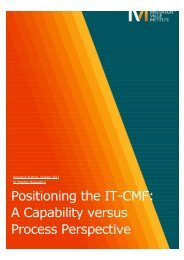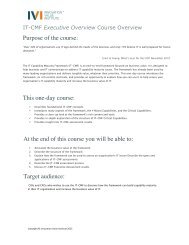Digital Capability - IVI Innovation Value Institute - National University ...
Digital Capability - IVI Innovation Value Institute - National University ...
Digital Capability - IVI Innovation Value Institute - National University ...
You also want an ePaper? Increase the reach of your titles
YUMPU automatically turns print PDFs into web optimized ePapers that Google loves.
The DCF is intended to help organisations<br />
measure and improve their digital capability<br />
on an enterprise-wide basis. It can also help<br />
organisations align their people, processes<br />
and technology in order to meet the<br />
challenges of the digital economy.<br />
Ultimately, the DCF helps organisations<br />
decide how much digital transformation is<br />
appropriate for their business – focusing at<br />
all times on the business value it will add.<br />
Measuring <strong>Digital</strong> <strong>Capability</strong><br />
Organisations frequently experience<br />
difficulty analysing the opportunities and<br />
challenges presented by the Internet.<br />
Consequently, many organisations are<br />
getting less value from their digital<br />
investments than they should be.<br />
Before dealing with the subject of how to<br />
measure digital capability itself, it is worth<br />
reviewing some related measurements,<br />
which have already been collated, that<br />
support the need for digital capability to be<br />
addressed.<br />
Firstly, figures recently published by AMAS<br />
[3] show just how few organisations have<br />
been taking full advantage of the digital<br />
opportunity. For example, in Ireland, only<br />
26% of organisations that have broadband<br />
are doing business online (see Figure 1).<br />
Secondly, many chief executives have<br />
ambitious digital aspirations that their<br />
organisations are simply not equipped to<br />
implement. Thirdly, up to now there have<br />
been no specialised advisers to tell chief<br />
executives what to do in such situations.<br />
Figure 1: How Irish Businesses use the Internet<br />
A recent UK study by Blue Latitude [4]<br />
revealed that 36% of organisations<br />
surveyed have no digital strategy at all;<br />
while 45% of organisations have no process<br />
for harnessing digital knowledge. The study<br />
also found that 56% of organisations have<br />
trouble hiring staff with digital skills. This<br />
increasingly occurs because traditional<br />
recruitment practices do not attract digitally<br />
savvy candidates.<br />
In addition to the above, a pilot digital<br />
capability assessment recently carried out<br />
by <strong>IVI</strong> provided indications that<br />
organisations are missing out on potential<br />
productivity gains because they are<br />
unaware of the latent digital capability<br />
within their workforce. This would indicate<br />
that in some cases the digital aspirations of<br />
the organisations are lagging behind those<br />
of their employees.<br />
<strong>IVI</strong> intends to measure digital capability<br />
using the same exacting techniques as for<br />
the other 33 core processes within its<br />
flagship IT-CMF. Using these techniques,<br />
top executives and practitioners will be able<br />
to adopt a number of interrelated strategies<br />
and associated maturity curves to help<br />
manage and deliver greater value from their<br />
digital investments.<br />
Essentially, digital capability provides a<br />
measure of the value that internal and<br />
external processes (which are based on<br />
digital technology) add to an organisation<br />
on an enterprise-wide basis, across all<br />
areas ranging from staff productivity to the<br />
quality of the customer experience. As well<br />
as having a current digital capability,<br />
organisations also have a future digital<br />
capability (called their digital potential).<br />
If digital capability and digital potential are<br />
regarded as start and end points, the<br />
journey in between is the digital<br />
transformation that the organisation needs<br />
to undergo. <strong>Digital</strong> capability is periodically<br />
reviewed along the way, with progress<br />
rewarded on the basis of increasing<br />
competency levels – ranging from one to<br />
five. The digital capability maturity levels<br />
and the <strong>Capability</strong> Building Blocks (CBBs)<br />
are shown in Figure 2.<br />
Page 4












